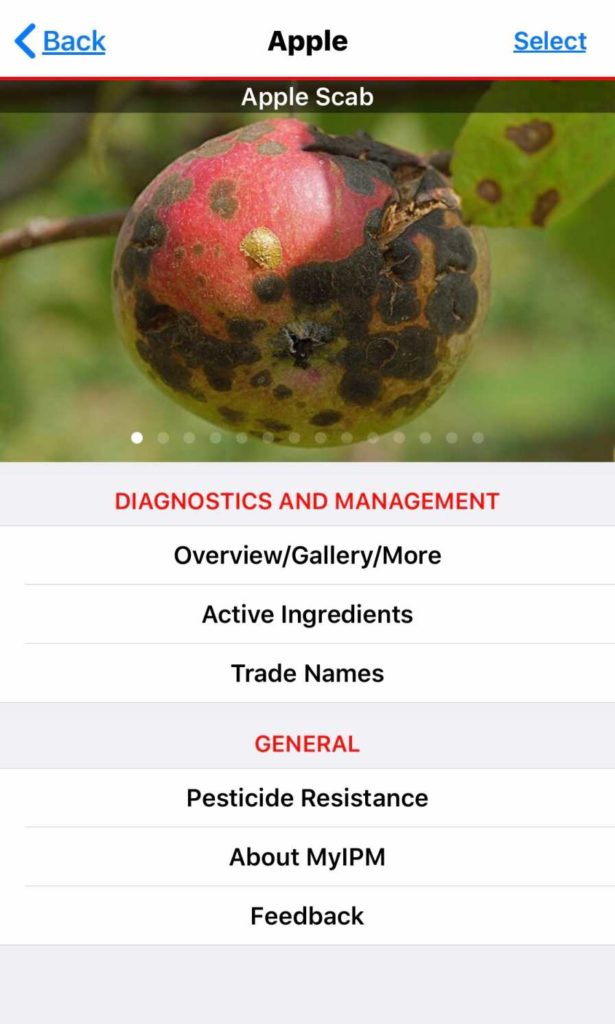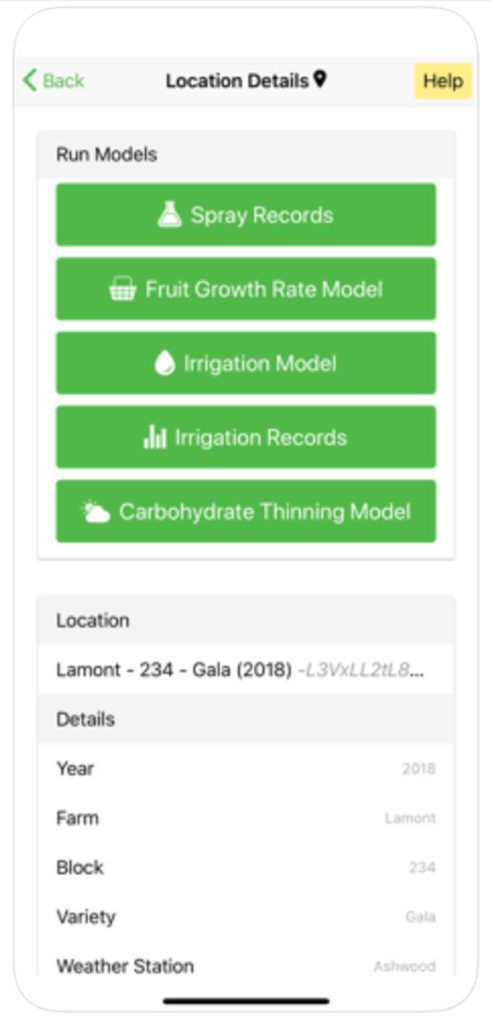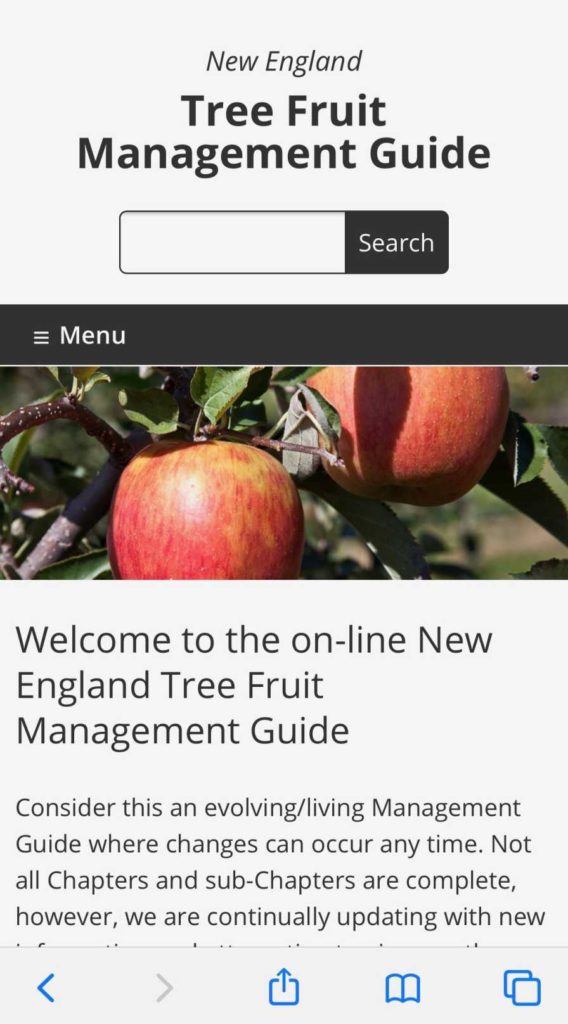4 Apps With Big Appeal for Fruit Growers
Although there are many handy apps out there you likely use in your orchard, I want to highlight four that I or University of Massachusetts faculty and staff (among others) have been involved in developing and/or testing and maintaining. The apps are: MyIPM, Eco Apple App, Malusim, and netreefruit.org.
MyIPM
MyIPM is a collaboration of plant pathologists and entomologists of multiple fruit crops in the Eastern U.S. to develop a handy tool to help with resistance management of fungicides and insecticides. For tree fruit growers, MyIPM includes apple, peach, pear, cherry, strawberry, and blueberry diseases and insects.
Once you select the crop and diseases or insects you are interested in, you will see a menu with information on diagnostics, management, and pesticide resistance. Sub-menus include overview/gallery/more, active ingredients, and trade names. To help with identification, a gallery of pictures of the particular malady are included. And just for fun, you can hear an audio transcript from a noted pathologist or entomologist.

The active ingredients and trade names of crop protectants for the specific disease or insect chosen are particularly helpful for resistance management, as the active ingredients are color-coded based on FRAC (fungicides) or IRAC (insecticides) Resistance Action Committee numbers.
The numerical FRAC/IRAC code is also included, as well as trade name, efficacy, rate, preharvest interval (PHI), re-entry interval (REI,) maximum number of sprays, and amount of product allowed per year. Trade names also include information from the Pesticide Risk Tool, which estimates the negative impacts of pesticide application. A bit more information, including downloadable links (Apple App Store and Google Android Play Store) are available at https://apps.bugwood.org/apps/myipmseries/.
MyIPM is updated annually and ongoing during the season.
ECO APPLE
The Eco Apple app is designed for growers using the Eco Apple protocol to quickly access allowed pesticide information based on apple growth stages (phenology). It is a collaboration of Red Tomato, IPM Institute of North America, and UMass.
To use the app, start by selecting the apple bud stage, then pests of interest. The app will show you a list of approved Eco Apple crop protectants that have been through a rigorous vetting process and present minimal risk to the environment and humans (i.e., applicators, workers, and consumers).

Once the pesticide is selected, information displayed includes type, rate per acre, active ingredient(s), eco restricted (“no” or “yes” with restriction details), EPA registration number, REI, PHI, signal word, RAC number, and manufacturer.
The Eco Apple app is a quick reference for Eco Apple growers in the field. It offers information on approved products and is updated annually. But it is also handy for anyone growing apples and choosing to use pesticides with minimal impact on human health and the environment while still providing effective pest control options. Search for Eco Apple App on the Apple App Store or Google Android Play Store.
MALUSIM
Malusim is an advanced app that includes the fruit growth rate model, irrigation model, and carbohydrate thinning model. After initial location/block(s) set-up, including a Network for Environment and Weather Applications (NEWA) station location (recommended but not necessary for all the models), the Malusim app can be used to enter fruit growth rate measurements (using either a keyboard or voice input) and predict apple fruit set during the chemical thinning season.
Predicted fruit set via the fruit growth rate model is immediately charted on screen, displaying either the number of fruit setting or percent fruit setting based on a specified target number of fruit. The carbohydrate thinning model is charted and displayed based on data from the selected NEWA weather station, which is helpful in determining chemical thinning timing and adjusting rates.

I am not as familiar with the irrigation model, however, in a nutshell it charts daily and cumulative water balance, orchard evapotranspiration (ET), and rainfall on a location based on input from the selected NEWA weather station. Irrigation records can be entered to adjust these values.
The Malusim app is still under development and admittedly has some bugs; be sure to export your data frequently! Malusim was primarily developed by Cornell University post-docs Poliana Francescatto and Jaume Lourdan, and funded by the New York Farm Viability Institute. It is available at the Apple App Store or Google Android Play Store.
NETREEFRUIT.ORG
Home of the New England Tree Fruit Management Guide, Netreefruit.org is a web-based app because it needs connectivity to a web server — typically not a problem in this day and age. It is not downloaded from one of the app stores. You can view Netreefruit.org using a web browser on your phone, tablet, or computer. Every orchardist in New England should be using it now for current pest and crop management information on apples, pears, peaches, plums, apricots, and cherries.

In addition to pesticide information ― timing, efficacy, rates, safety, pests controlled, etc. ― weeds, wildlife, nutrients, sprayer calibration, organic, and crop insurance information are available and updated annually. It is a living “document,” so collaborating tree fruit specialists in all six New England states can make changes to recommendations, etc. anytime, on-the-fly.
Netreefruit.org was designed as “responsive,” which means it is user-friendly whether using a small, mobile phone screen (although they are getting bigger!) or a bigger tablet or computer screen. Quick plug: Be sure to bookmark netreefruit.org on your phone, tablet, and computer for quick reference to all your New England orchard management questions and recommendations.










